A Guide To Remote First Aid
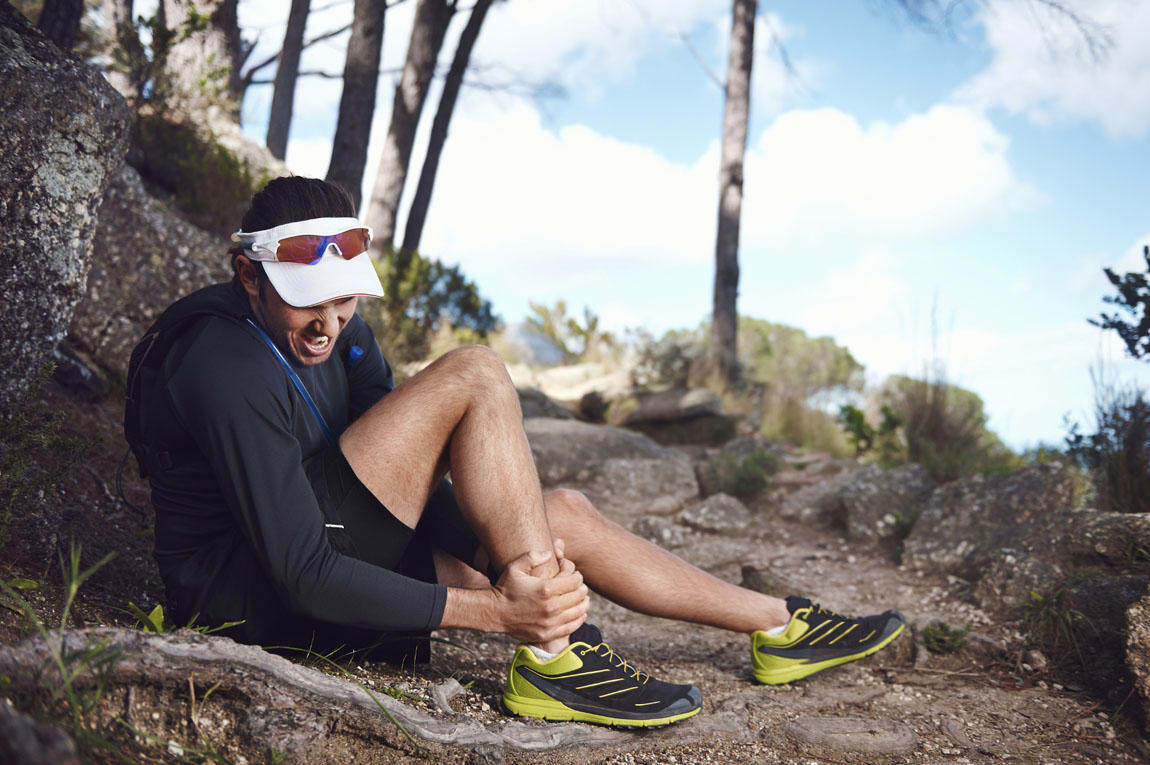
Outdoor activities in remote areas are often strenuous and challenging. Due to the nature of these activities and the often unpredictable environment, extra precautions must be taken before you embark on your adventure.
Hikes through thick forestry, off-road camping, and offshore fishing trips are part of Australia’s beloved outdoor culture. But every outdoor adventure, no matter how often you’ve done it before, should always begin with the preparation for a remote First Aid emergency.
Because you are in a remote area, possibly hours from help, emergency services may be delayed in accessing your location. This is why it’s so important that every outdoor adventure-lover should know how to provide remote First Aid for the duration of the time it may take for medical assistance to arrive.
Follow our tips on how to prepare, how to provide trauma management and how to deliver patient care to ensure you’re ready if a remote First Aid emergency occurs on your next outdoor escape.
Plan For An Emergency
If you’re planning an off-road camping trip, a long hike in thick bush or off-shore fishing voyage, the first thing you should do is create an emergency response plan. Prior to your departure, follow this guide:
- Create a record of each group members medical history and needs and ensure everyone knows where to find the records in an emergency
- Ensure your First Aid kit is up-to-date and fully stocked before departure
- Check weather reports and pre-plan routes thoroughly
- Provide someone who is not accompanying you on your journey with your route details, what time to expect you back from the trip and what to do if they do not hear from you by that time
- Always ensure you have enough food and water to last you a few extra days in case you get stranded
- Who will be the group leader if a First Aid emergency occurs
- Avoid travelling alone

The Role Of Your Outdoor Group First Aider
Once you have decided who in your travel group will be the First Aid leader, they must take control if the need for remote First Aid occurs.
The First Aider Must:
- Consider whether the casualty is fit to continue the activity or requires medical assistance
- Assess if the casualty should be taken to medical assistance or if medical assistance should come to them
- Ensure the casualty is as comfortable as possible during transportation to medical assistance or whilst waiting for medical assistance
- Ensure the casualty is not exposed to any conditions which may contribute to the deterioration of their state such as wind, rain, snow, cold or hot weather conditions
- Monitor and record the casualty’s condition with a view to handing over to medical help when they arrive. This will help with their evaluation of the casualty’s condition
- Monitor and record fluid intake and output
- Provide consistent reassurance to the casualty, as the longer it takes to receive medical assistance the more likely they are to go into shock
Trauma Management Plan
If you’re on a remote outdoor trip and a member of your group suffers from a serious injury such as a broken leg or serious wound, follow this trauma management plan whilst waiting for medical assistance.
Step 1. Assess the situation
If a member of your group slips on a cliff ledge and falls a few meters down, you must visually assess whether they are injured – are there any signs of blood, dislocation or unconsciousness?
If you can see they have suffered a serious injury call triple zero (000) immediately.
Step 2. Check for danger
Before you get any closer to the casualty you must assess if the environment is dangerous to you or the casualty. If you can remove the danger from the scene, do so before you move in to help. If there is a risk you will injure yourself by approaching, call triple (000)
If there is a risk you will injure yourself by approaching the casualty, the situation is deemed dangerous and unsafe. In this case you must call triple zero (000), explain the situation and wait for their arrival.
Step 3. Check the casualty is breathing
Conscious casualty: ask them if they can breathe comfortably. If they answer YES ask them to take a deep breath. If they cannot breathe normally check that they have not endured a chest injury.
If you have discovered the casualty is having difficulty breathing you must roll them on their side to assist their breathing.
Unconscious casualty: you must roll them onto their side immediately, check there is nothing in their mouth blocking the airways to ensure the airways are clear and open.
If the casualty does not seem to be breathing you must roll them onto their back and perform CPR.
- Check there is nothing in their mouth and their airway is clear
- Apply 30 compressions
- Provide 2 breaths
- Repeat compressions and breaths at a rate of 30:2 until help arrives or the casualty starts breathing
If casualty is suffering life-threatening bleeding, control this as a priority BEFORE commencing CPR.
Step 4. Stop bleeding
If a lot of blood is being lost from a wound you must try to stop the bleeding. If you do not have the equipment in your remote First Aid kit you can use clothing or a towel to create a provisional pad. Hold the pad firmly against the wound and apply pressure until the bleeding stops.
Step 5. Stabilise head and neck
If the casualty has suffered a head or neck injury you must stabilise their head or neck to ensure they can breathe comfortably.
You can do this with your hands or with a soft item such as a towel or jumper than you can place underneath and around the head and neck to prevent any additional movement.
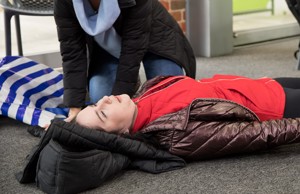 |
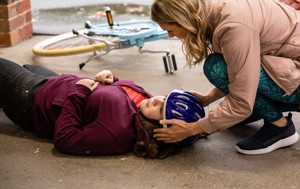 |
Step 6. Complete full body assessment
Complete a head-to-toe assessment of the casualty to ensure there are no unrecognised serious injuries such as large wounds or broken bones.
Step 7. History
If the casualty’s condition is stabilised and they are conscious, find out their medical history if you do not already have it recorded. This will assist medical staff when they arrive.
Check for issues such as allergies, current and past medical conditions, medications and dosage.
When recording the casualty’s history apply the SAMPLE acronym:
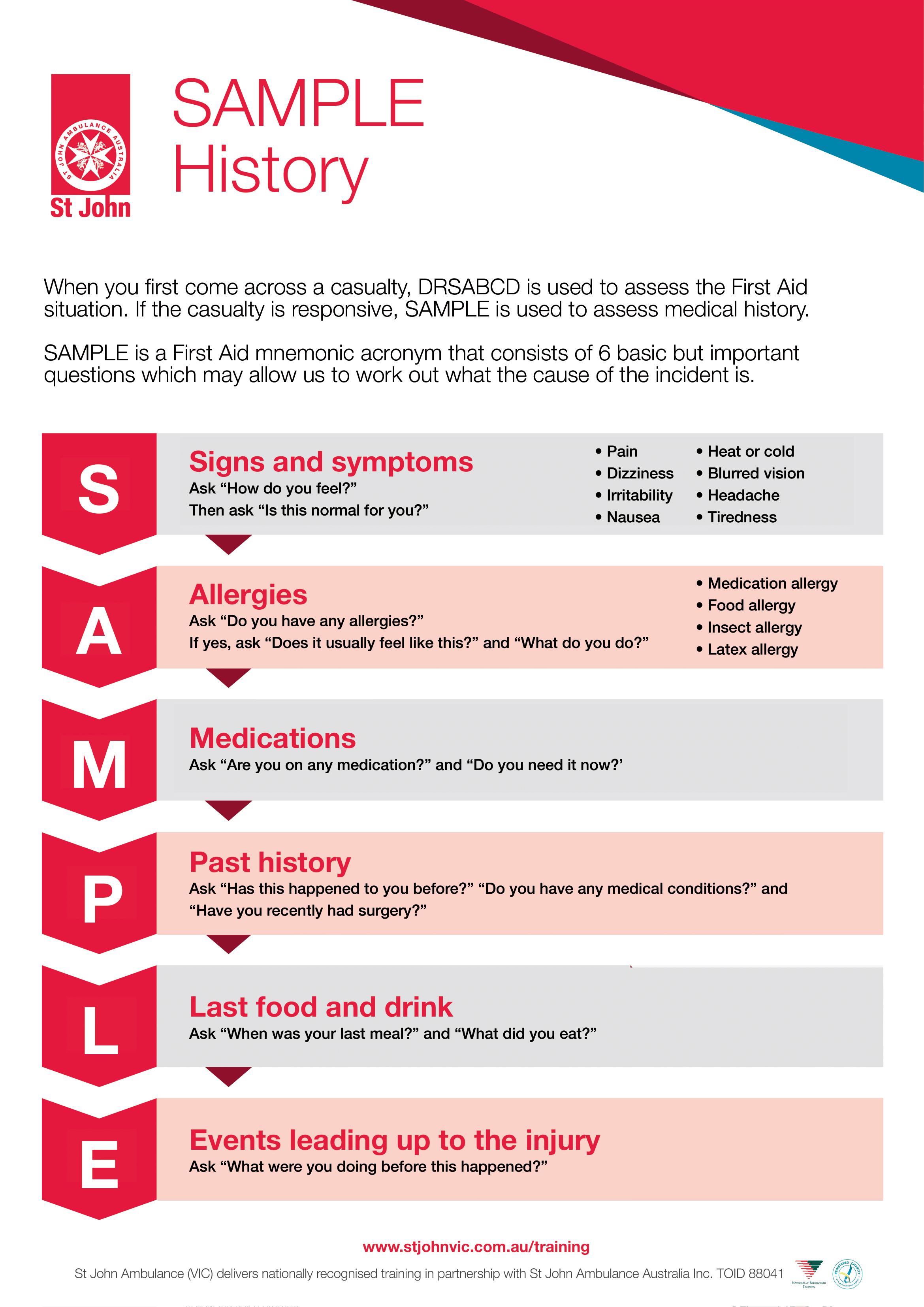
Patient Care
Their condition can worsen over time so it’s imperative you are diligently monitoring and recording the state of their condition. A record of this information is incredibly useful to emergency services when they take over care.
If a casualty is severely injured you should monitor and record their condition in 15-minute intervals. For lesser injuries, half-hour intervals will suffice.
Important characteristics to take note of when monitoring a casualty:
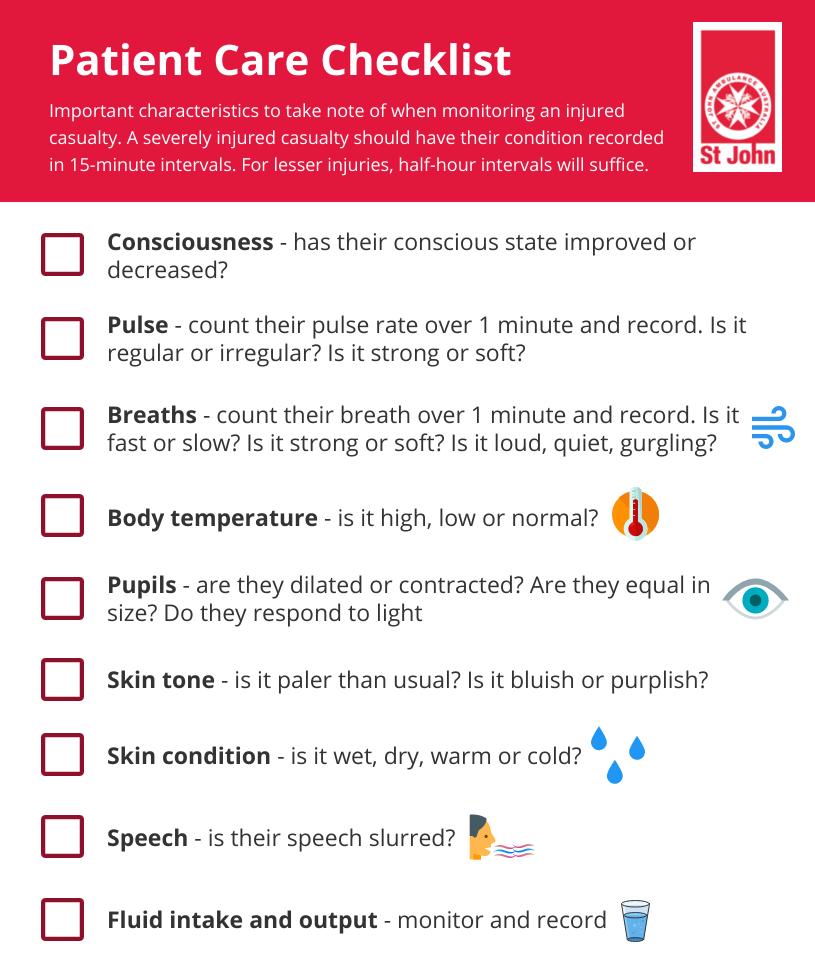
Moving a Patient During Remote First Aid
A casualty with a serious injury should only ever be moved if they are in danger or the benefits outweigh the possible risks.
Situations where it is acceptable to move a casualty include:
- Uncomfortable weather conditions such as storms, lightning, flood or fire
- Dangerous positioning such as on a cliff edge
- Exposure to irritation such as ants, bees and other insects
- Contact with items that may cause infection such as dirt, weeds, oil
Fluid Intake and Output
You must record all fluid intake and output to handover to medical staff upon arrival. Important things to remember about fluid intake and output include:
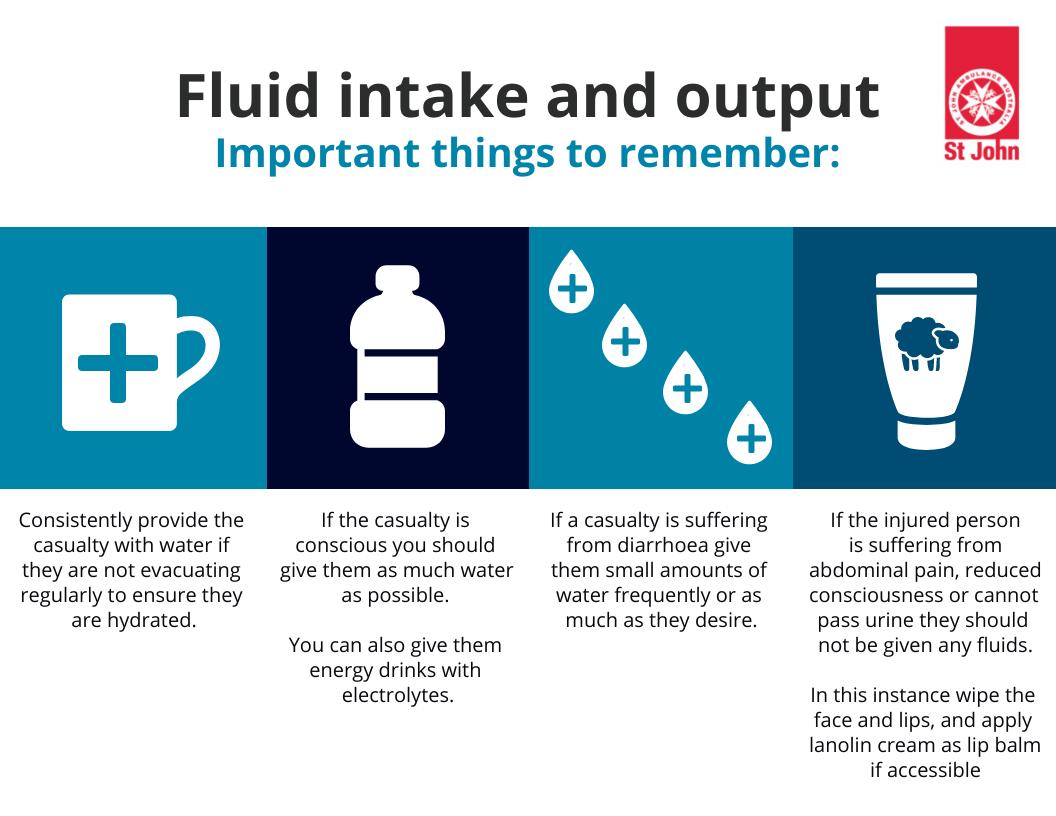
General Tips:
- Moisten the casualty’s lips with water for the first 4-8 hours after injury
- Provide half a cup of water every 30 minutes if medical aid has not arrived after 4-8 hours (if its summertime increase the amount)
- If the casualty is vomiting from water intake do not give them any more
- If you suspect the casualty will be going into surgery within 4-6 hours, stop any food or fluid intake
Important things to record:
- Amount of water intake
- Vomiting
- Passing urine
- Loss of blood
- Developing diarrhoea
Australia is renowned for its natural beauty, because of that we embrace the outdoors more than many other countries around the world. Experienced outdoors people are well aware of the risks involved when travelling to remote areas and it’s critical that every person prepares for the worst prior to their departure.
Camping, fishing, hiking, climbing and horseriding are some of the common remote outdoor activities Australians grow up enjoying. But no matter how experienced you are in these activities, the need for remote First Aid is unpredictable and does not discriminate.
Ensure you’re ready if a remote First Aid event occurs on your next outback adventure by following our tips. Preparation will reduce stress in a high-pressure situation, provide comfort to the injured and guarantee the correct care is provided whilst waiting for medical assistance to arrive.
A few simple steps could make a huge difference to your outdoors groups’ readiness for an emergency – preparation for remote First Aid is an investment worth making.
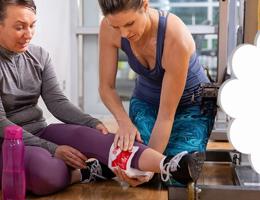
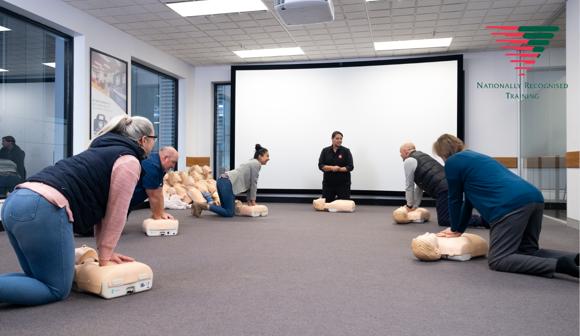
PROVIDE FIRST AID
Learn how to manage a range of common first aid scenarios.
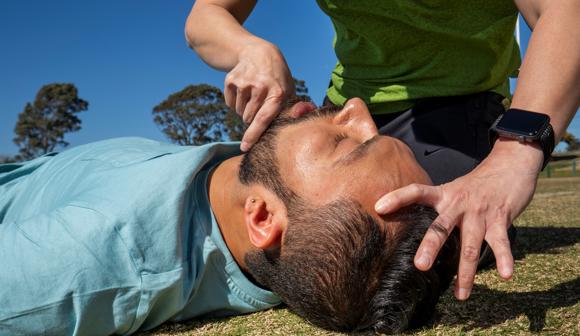
Provide first aid in remote situations
Learn how to provide ongoing care to an ill or injured casualty in remote areas.
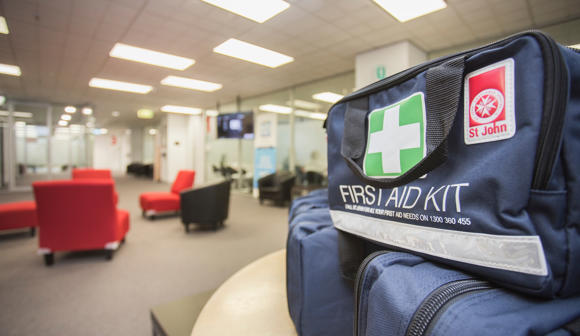
DO YOU HAVE THE RIGHT FIRST AID KIT FOR YOUR HOME, SCHOOL OR WORKPLACE?
St John has a range of First Aid products to suit any situation.
